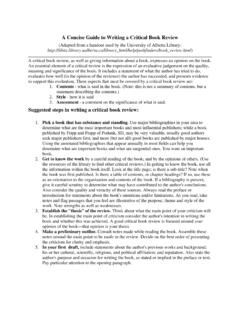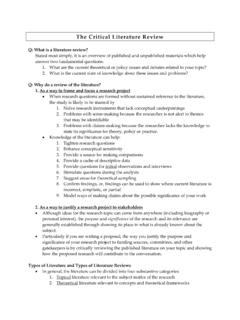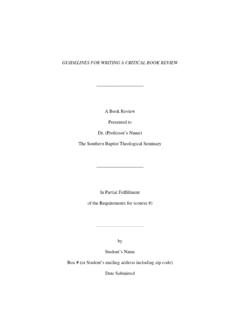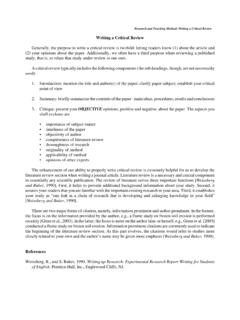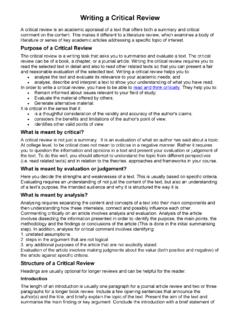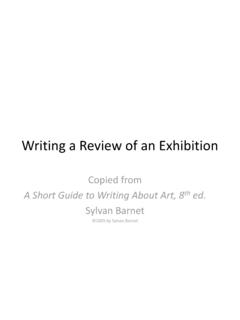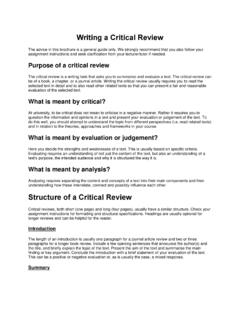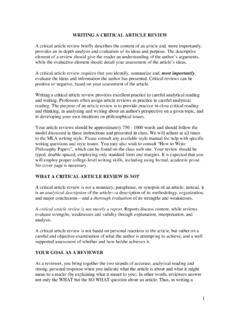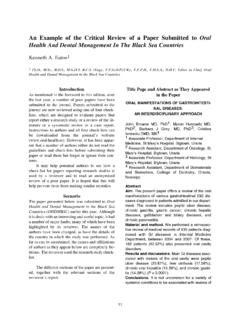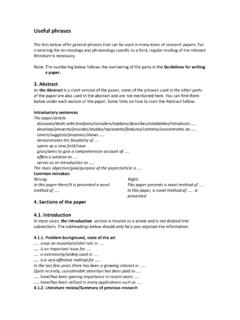Transcription of Writing a Critical Review - Canyons School District
1 This work is licensed under a Creative Commons Attribution- NonCommercial- ShareAlike United States License. Lesson Title: Argumentative Writing ( Writing a Critical Review ) Author: Carl Myers, DeeAnne Simonson Subject Area(s): Type an X in the box to the left of the subject area(s) addressed in this lesson: Subject Area(s) Standard 1: Social and Instructional Language x Standard 2: The Language of Language Arts Standard 3: The Language of Mathematics Standard 4: The Language of Science Standard 5: The language of Social Studies The Language of Music and Performing Arts The Language of Visual Arts The Language of Technology and Engineering The Language of Health and Physical Education The Language of the Humanities Other: _____ Topic.
2 Argumentative Writing with Romeo and Juliet Grade Levels: 9 Language Domain(s): Type an X in the box to the left of the language domain(s) addressed in this lesson. Language Domain(s) Speaking x Reading x Writing Listening Approximate Duration: 3 hours of instructional time (more for reading play and watching movie) Content Standards: Cite strong and thorough textual evidence to support analysis of what the text says explicitly as well as inferences drawn from the text. Write arguments to support claims in an analysis of substantive topics or texts, using valid reasoning and relevant and sufficient evidence. This work is licensed under a Creative Commons Attribution- NonCommercial- ShareAlike United States License.
3 Use words, phrases, and clauses to link the major sections of the text, create cohesion, and clarify the relationships between claim(s) and reasons, between reasons and evidence, and between claim(s) and counterclaims. Establish and maintain a formal style and objective tone while attending to the norms and conventions of the discipline in which they are Writing . Cognitive Function: How will you ensure that all students will have opportunities to engage in the same cognitive challenge? Language Target: Level 4- Expanding Correctly use technical content vocabulary in short, expanded, and complex sentences Express ideas in an organized manner, with emerging cohesion of ideas. Language Supports: Type an X in the box to the left of any supports that will be used in the lesson.
4 Sensory Support Graphic Support Interactive Support Real- life objects (realia) Charts x In pairs or partners Manipulatives Number Lines In triads or small groups Pictures & photographs Tables In whole group Illustrations & diagrams Graphs Using cooperative group structures x Magazines & newspapers Timelines Physical activities x Graphic organizers: VENN DIAGRAM x Using the Internet or software programs x Videos & films Broadcasts Models & figures In the native language Other:_____ Other:_____ With mentors Other:_____ Description of supports: Magazines and Newspapers- students will use reviews from these printed sources as models. Films- students will watch an adaptation of Romeo and Juliet as text support and also as a context for their film Review .
5 Graphic Organizer- Students will use a Venn Diagram to organize their compare/contrast ideas between the original and adaptation. In pairs or partners- Students will use partners as support for examining both printed and visual text. Students may aid each other in comprehension. Internet- Students will use the Internet to find examples of Critical reviews about topics they are interest in. This work is licensed under a Creative Commons Attribution- NonCommercial- ShareAlike United States License. Assessment and Feedback: Content/Language Assessment: Context: Students should already be familiar with the purposes and organization of argumentative or persuasive Writing . Their familiarity with story elements should allow them to examine a work of literature, either printed or visual ( film) at a proficient level.
6 Lesson Description: Enduring Understanding: In order to develop and share opinions about the word around them, students need to be able to read and write critically by: identifying and evaluating others opinions forming their own opinions and defending them with evidence. Rationale: Critical reviews are real- world examples of argumentative Writing that have the potential to engage students across various interest and ability levels. Once this skill is mastered, students can choose their own area of interest and explore and write reviews of products, services, etc. related to that area. This is intended to be an end of the year lesson reviewing the steps to argumentative Writing and allowing students to apply those steps while Writing for a real audience- their peers.
7 Content Learning Objectives: - Write about an opinion using valid reasoning and supporting evidence. Grading Rubric for Critical Review Thesis The student communicates a plausible thesis containing a clear opinion and reasons for the opinion. The thesis focuses on differences or similarities between one story element in both adaptations. 4- Advanced 3- Proficient 2- Needs Support 1- No evidence Comments: Supporting Evidence The student cites and thoroughly explains evidence supporting the thesis. The evidence consists of relevant, sufficient details from the original and adaptation. 4- Advanced 3- Proficient 2- Needs Support 1- No evidence Comments: Vocabulary The student effectively uses genre- specific vocabulary within their Review .
8 4- Advanced 3- Proficient 2- Needs Support 1- No evidence Comments: Tone Student effectively communicated a specific tone. The tone enhances the overall purpose of the Review . 4- Advanced 3- Proficient 2- Needs Support 1- No evidence Comments: This work is licensed under a Creative Commons Attribution- NonCommercial- ShareAlike United States License. - Anticipate audience knowledge and interest in topic and adjust content accordingly. - Maintain style and tone consistent with the type of Writing being produced. Language Learning Objectives: - Review key vocabulary related to different types of argumentative Writing .
9 - Use argumentative vocabulary to aid in supporting and defending a claim. Resources: Various interpretation of The Tragedy of Romeo and Juliet. Possible ideas include: Romeo and Juliet- Zefferelli Romeo and Juliet- Luhrmann Gnomeo and Juliet- Romeo and Juliet Graphic Novels Romeo and Juliet No Fear Version Computers Examples of Critical reviews for contemporary movies and books Highlighters Venn diagrams (Inspiration 9 or on paper) Task 1: Choose an act, scene, or possibly the whole play, for comparing with the same act, scene, etc., from a different interpretation of R+J. Read and view both versions while recording differences and similarities on a Venn diagram. The teacher should choose one criteria to record on his/her own in order to model for students during breaks from the movie.
10 Task 2: Teacher divides students up into cooperative learning groups, with each focusing on one similarity or difference in plot, setting, character, or theme. Remind students that all elements effect theme and will tie back to that element during the Writing phase. In groups, they will identify similarities and differences between one element of the versions they are comparing. By this time students should already be able to analyze a work of fiction based on various criteria, including plot, characterization, or theme. Task 3: Students independently write a three- pronged thesis statement focused on whether they would recommend this interpretation to others who are interested in the story of Romeo and Juliet.

